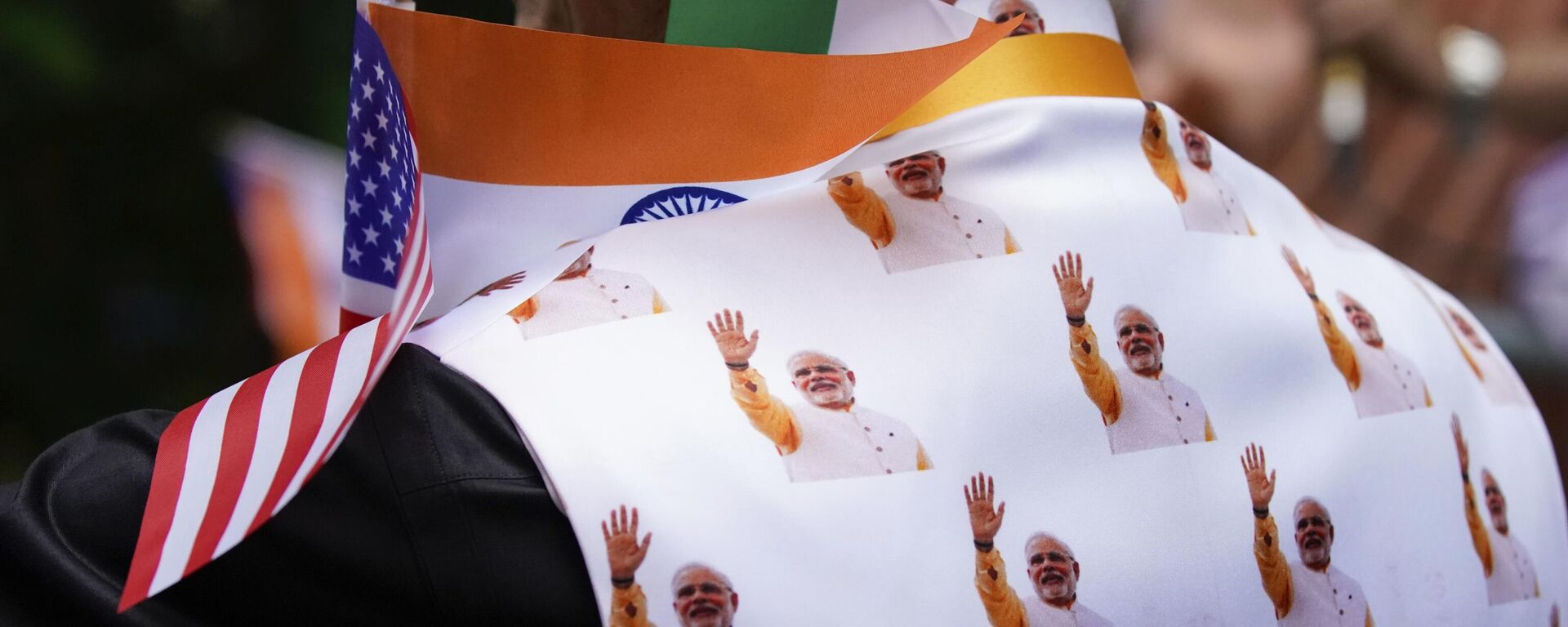https://sputniknews.in/20231110/closer-alignment-with-us-puts-india-on-wrong-side-of-history-expert-5345181.html
Closer Alignment with US Puts India on Wrong Side of History: Expert
Closer Alignment with US Puts India on Wrong Side of History: Expert
Sputnik India
A closer strategic alignment with the US is not in India’s “long-term interest” at a time when the power has been shifting away from the western countries to developing nations, a strategic affairs expert has told Sputnik India.
2023-11-10T20:56+0530
2023-11-10T20:56+0530
2023-11-10T20:56+0530
sputnik opinion
india
us
china
indian navy
joe biden
narendra modi
antony blinken
indo-pacific
quad
https://cdn1.img.sputniknews.in/img/07e7/06/17/2634001_0:160:3072:1888_1920x0_80_0_0_ee9d274aebafe7b22b8f31486a5ece3c.jpg
A closer strategic alignment with the US is not in India’s “long-term interest” at a time when the power has been shifting away from the western countries to developing nations, an Indian strategic affairs expert and author has told Sputnik India.The Indian expert reckoned that India must look at its national interest, which was directly linked to its geography.Sawhney asserted that the interests of India, which calls itself as ‘Voice of Global South', were more in line with China and Russia—the two major powers in Global South.Both Russia and China have been labelled as “immediate” and long-term geopolitical rivals in President Joe Biden’s National Security Strategy (NSS) released last year.As part of its policy to contain China’s growing global stature, the US has officially designated India as a key partner in Indo-Pacific.Sawhney claimed that the policy of India and the US as far as China is concerned was “more or less in alignment”.For India’s part, it has been involved in a protracted border issue with China in the eastern Ladakh region since April-May 2020.Russian military supplies accounted for around 45 percent of India’s overall arms imports between 2017-22, according to estimates by Stockholm International Peace and Research Institute (SIPRI).Washington's Aim of India-US Defence Relationship is to 'Wean India Away from Russia'Although India professes the policy of strategic autonomy and is not part of any US-led alliance, its ties with Washington in critical sectors such as defence have grown rapidly in the last few years.American defence exports to India have grown from nil in 2008 to almost $20 billion in 2020, making it New Delhi’s third-biggest supplier after Russia and France.Since last year, the two countries have agreed to a 'Roadmap for US-India Defence Industrial Cooperation' to bolster cooperation in co-production of air combat and land mobility systems, intelligence, surveillance, and reconnaissance, munitions, and the undersea domain.Sawhney said that the defence relationship was the “core component” of the growing India-US strategic partnership.“The US also wants that Prime Minister Narendra Modi’s ‘Make in India’ policy, or ‘atmanirbharta’ (self-reliance), is seen as successful, for their own strategic reasons,” the expert added.He warned that as far as interoperability was concerned, India was already a part of “US-led network” in Indo-Pacific through increased naval engagements in recent years.He explained that India’s Maritime Domain Awareness constituted the Indian Ocean, southeast Asian nations, which is the west Pacific, and the Pacific nations, or Oceania.Talking about the “innovation pillar” of India-US defense ties, Sawhney stated that the US was seeking investments to develop technologies in areas in which it had an interest.Sawhney underlined that America’s intentions in forging closer defense ties with India were purely “strategic” in nature and served American interests more than India’s.“We must remember that US Secretary of State Antony Blinken visited Israel, Jordan, Turkiye, South Korea and Japan before arriving in India. The US wants to show to China that it has reinforced its deterrence against China ahead of a possible meeting between Biden and President Xi Jinping, possibly at the Asia-Pacific Economic Cooperation (APEC) Summit in San Francisco this week,” the expert opined.He predicted that dealing with Xi from a “position of strength” would help Biden’s poll ratings ahead of the presidential election next year.
https://sputniknews.in/20230621/expert-warns-against-trading-indias-strategic-autonomy-for-alignment-with-us-2596650.html
india
us
china
indo-pacific
middle east
indian ocean
ukraine
russia
galwan valley
global south
ladakh
israel
Sputnik India
feedback.hindi@sputniknews.com
+74956456601
MIA „Rossiya Segodnya“
2023
Dhairya Maheshwari
https://cdn1.img.sputniknews.in/img/07e6/0c/13/138962_0:0:641:640_100x100_80_0_0_2cb44360dbcdf6d84bf4b299cd045917.jpg
Dhairya Maheshwari
https://cdn1.img.sputniknews.in/img/07e6/0c/13/138962_0:0:641:640_100x100_80_0_0_2cb44360dbcdf6d84bf4b299cd045917.jpg
News
en_IN
Sputnik India
feedback.hindi@sputniknews.com
+74956456601
MIA „Rossiya Segodnya“
Sputnik India
feedback.hindi@sputniknews.com
+74956456601
MIA „Rossiya Segodnya“
Dhairya Maheshwari
https://cdn1.img.sputniknews.in/img/07e6/0c/13/138962_0:0:641:640_100x100_80_0_0_2cb44360dbcdf6d84bf4b299cd045917.jpg
us india 2 2 dialogue, us india 2 2, us india relations, us india strategic clean energy partnership, us india news, us india trade, israel india relations, israel india news, israel hamas war, xi biden meeting, xi us visit, india china dispute, india russia news, apec summit
us india 2 2 dialogue, us india 2 2, us india relations, us india strategic clean energy partnership, us india news, us india trade, israel india relations, israel india news, israel hamas war, xi biden meeting, xi us visit, india china dispute, india russia news, apec summit
Closer Alignment with US Puts India on Wrong Side of History: Expert
India and the US held the fifth edition of 2+2 Dialogue in New Delhi on Friday. Indian foreign minister S. Jaishankar said that the talks focussed on expanding strategic cooperation.
A closer strategic alignment with the US is not in India’s “long-term interest” at a time when the power has been shifting away from the western countries to developing nations, an Indian strategic affairs expert and author has told Sputnik India.
“It places us on the wrong side of geopolitics and history,” said Pravin Sawhney, who has authored bestseller The Last War: How AI Will Shape India’s Final Showdown With China.
The Indian expert reckoned that India must look at its national interest, which was directly linked to its geography.
“At a time when the world is undergoing such a major transformation in areas of geopolitics, technology, economy, India can’t afford to be seen as aligned with the US,” Sawhney cautioned.
"America has been trying to align the Indian view with its policy on the Middle-East tensions and the Ukraine crisis,” he stressed.
Sawhney asserted that the interests of India, which calls itself as ‘Voice of Global South', were more in line with China and Russia—the two major powers in Global South.
Both Russia and China have been labelled as “immediate” and long-term geopolitical rivals in President Joe Biden’s National Security Strategy (NSS) released last year.
As part of its policy to contain China’s growing global stature, the US has officially designated India as a key partner in Indo-Pacific.
Sawhney claimed that the policy of India and the US as far as China is concerned was “more or less in alignment”.
For India’s part, it has been involved in a
protracted border issue with China in the eastern Ladakh region since April-May 2020.
“I think the closer alignment with the US is a foreign policy decision provoked by the Galwan Valley clashes at the Line of Actual Control (LAC) in June 2020. But it doesn’t serve India’s long-term interests,” Sawhney reckoned.
The author further echoed concerns that the US has been consistently engaged to try and wean India away from Russian military hardware. The India-Russia Special and Privileged Strategic Partnership is underpinned by decades of strategic cooperation that started in the Cold War-era.
Russian military supplies accounted for around 45 percent of India’s overall arms imports between 2017-22, according to estimates by Stockholm International Peace and Research Institute (SIPRI).
Washington's Aim of India-US Defence Relationship is to 'Wean India Away from Russia'
Although India professes the
policy of strategic autonomy and is not part of any US-led alliance, its ties with Washington in critical sectors such as defence have grown rapidly in the last few years.
American defence exports to India have grown from nil in 2008 to almost $20 billion in 2020, making it New Delhi’s third-biggest supplier after Russia and France.
Since last year, the two countries have agreed to a 'Roadmap for US-India Defence Industrial Cooperation' to bolster cooperation in co-production of air combat and land mobility systems, intelligence, surveillance, and reconnaissance, munitions, and the undersea domain.
Sawhney said that the
defence relationship was the “core component” of the growing India-US strategic partnership.
He explained that US has been fashioning the defence ties with India on three pillars to serve American interests.
Sawhney described these pillars as defence production, enhancing interoperability and innovation.
“The primary aim of India-US defence relationship (for Washington) is to wean India away from Russian arms,” Sawhney explained.
“The US also wants that
Prime Minister Narendra Modi’s ‘Make in India’ policy, or ‘atmanirbharta’ (self-reliance), is seen as successful, for their own strategic reasons,” the expert added.
He warned that as far as interoperability was concerned, India was already a part of “US-led network” in Indo-Pacific through increased naval engagements in recent years.
“The Indian Navy is now looking at the possibility of working beyond what used to be their areas of interest and influence. The Indian Navy is a part of the US-led Maritime Domain Awareness in Indo-Pacific,” Sawhney noted.
He explained that India’s Maritime Domain Awareness constituted the Indian Ocean, southeast Asian nations, which is the west Pacific, and the Pacific nations, or Oceania.
Talking about the “innovation pillar” of India-US defense ties, Sawhney stated that the US was seeking investments to develop technologies in areas in which it had an interest.
“We have now decided on certain start-ups in certain technologies. The aim of the Americans is to get investors, be it from India or the US, in the areas in which the Americans have interest,” he claimed.
Sawhney underlined that America’s intentions in forging closer defense ties with India were purely “strategic” in nature and served American interests more than India’s.
“We must remember that US Secretary of State Antony Blinken visited Israel, Jordan, Turkiye, South Korea and Japan before arriving in India. The US wants to show to China that it has reinforced its deterrence against China ahead of a possible meeting between Biden and President Xi Jinping, possibly at the Asia-Pacific Economic Cooperation (APEC) Summit in San Francisco this week,” the expert opined.
He predicted that dealing with Xi from a “position of strength” would help Biden’s poll ratings ahead of the presidential election next year.



